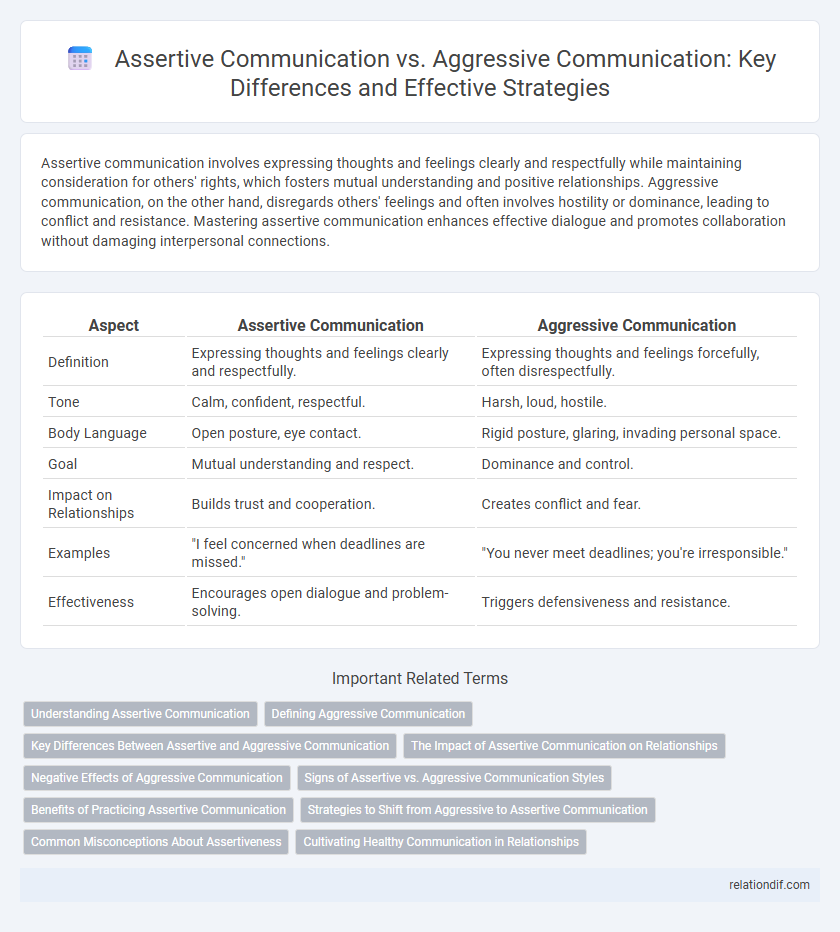Assertive communication involves expressing thoughts and feelings clearly and respectfully while maintaining consideration for others' rights, which fosters mutual understanding and positive relationships. Aggressive communication, on the other hand, disregards others' feelings and often involves hostility or dominance, leading to conflict and resistance. Mastering assertive communication enhances effective dialogue and promotes collaboration without damaging interpersonal connections.
Table of Comparison
| Aspect | Assertive Communication | Aggressive Communication |
|---|---|---|
| Definition | Expressing thoughts and feelings clearly and respectfully. | Expressing thoughts and feelings forcefully, often disrespectfully. |
| Tone | Calm, confident, respectful. | Harsh, loud, hostile. |
| Body Language | Open posture, eye contact. | Rigid posture, glaring, invading personal space. |
| Goal | Mutual understanding and respect. | Dominance and control. |
| Impact on Relationships | Builds trust and cooperation. | Creates conflict and fear. |
| Examples | "I feel concerned when deadlines are missed." | "You never meet deadlines; you're irresponsible." |
| Effectiveness | Encourages open dialogue and problem-solving. | Triggers defensiveness and resistance. |
Understanding Assertive Communication
Assertive communication involves expressing thoughts, feelings, and needs honestly and respectfully while valuing others' opinions, fostering clear and effective interaction. It contrasts with aggressive communication, which often disregards others' rights, leading to conflict and misunderstanding. Mastering assertive communication enhances personal and professional relationships by promoting mutual respect and collaboration.
Defining Aggressive Communication
Aggressive communication is characterized by expressing thoughts and feelings in a hostile, disrespectful, or domineering manner that often violates others' rights. It involves shouting, blaming, or using threatening language to control or intimidate, leading to conflict and damaged relationships. This communication style diminishes trust and collaboration, contrasting sharply with assertive communication, which promotes respectful and clear expression.
Key Differences Between Assertive and Aggressive Communication
Assertive communication involves expressing thoughts and feelings openly and respectfully while maintaining control over emotions, promoting mutual understanding and positive relationships. Aggressive communication, by contrast, prioritizes dominating or intimidating others, often through hostility or disrespect, which can lead to conflict and damaged interactions. Key differences include tone of voice, body language, and intent--assertive communicators seek collaboration, whereas aggressive communicators aim to overpower.
The Impact of Assertive Communication on Relationships
Assertive communication fosters trust and respect by clearly expressing needs and boundaries without violating others' rights, enhancing relationship quality. This communication style reduces misunderstandings and conflict while promoting empathy and collaboration between individuals. Unlike aggressive communication, assertiveness builds long-term emotional safety and mutual understanding, crucial for healthy and effective interpersonal connections.
Negative Effects of Aggressive Communication
Aggressive communication often leads to damaged relationships, as it involves hostility, disrespect, and domination that alienate others. This communication style increases conflict, resulting in misunderstandings and reduced collaboration in both personal and professional environments. Chronic exposure to aggressive communication can elevate stress levels and lower overall emotional well-being for all parties involved.
Signs of Assertive vs. Aggressive Communication Styles
Assertive communication involves expressing thoughts and feelings clearly while respecting others, characterized by calm tone, steady eye contact, and open body language. Aggressive communication displays hostility or dominance, marked by raised voice, interrupting, glaring, and intrusive gestures. Recognizing these signs helps improve interpersonal interactions and conflict resolution skills.
Benefits of Practicing Assertive Communication
Practicing assertive communication enhances clarity and mutual respect, fostering healthier interpersonal relationships and reducing misunderstandings. It empowers individuals to express their thoughts and feelings confidently without infringing on others' rights, promoting balanced and effective dialogue. Consistent assertive communication also improves emotional intelligence and conflict resolution skills, contributing to a positive social and professional environment.
Strategies to Shift from Aggressive to Assertive Communication
Implementing clear, respectful language and active listening techniques facilitates the transition from aggressive to assertive communication. Utilizing "I" statements to express feelings without blaming encourages constructive dialogue and reduces conflict escalation. Practicing emotional regulation and seeking feedback enhances self-awareness, promoting a balanced and confident communication style.
Common Misconceptions About Assertiveness
Many people mistakenly equate assertive communication with aggressiveness, assuming that being assertive means dominating or disrespecting others. Assertiveness actually involves expressing one's thoughts and feelings clearly and respectfully while maintaining others' rights and viewpoints. Understanding this distinction improves interpersonal communication and reduces conflicts by fostering mutual respect and clarity.
Cultivating Healthy Communication in Relationships
Assertive communication fosters mutual respect by clearly expressing thoughts and feelings while honoring others' boundaries, enhancing trust and understanding in relationships. Aggressive communication, characterized by hostility and disregard for others' perspectives, damages emotional connections and increases conflict. Cultivating assertiveness promotes healthier dialogue, enabling partners to resolve disagreements constructively and maintain emotional intimacy.
Assertive communication vs Aggressive communication Infographic

 relationdif.com
relationdif.com